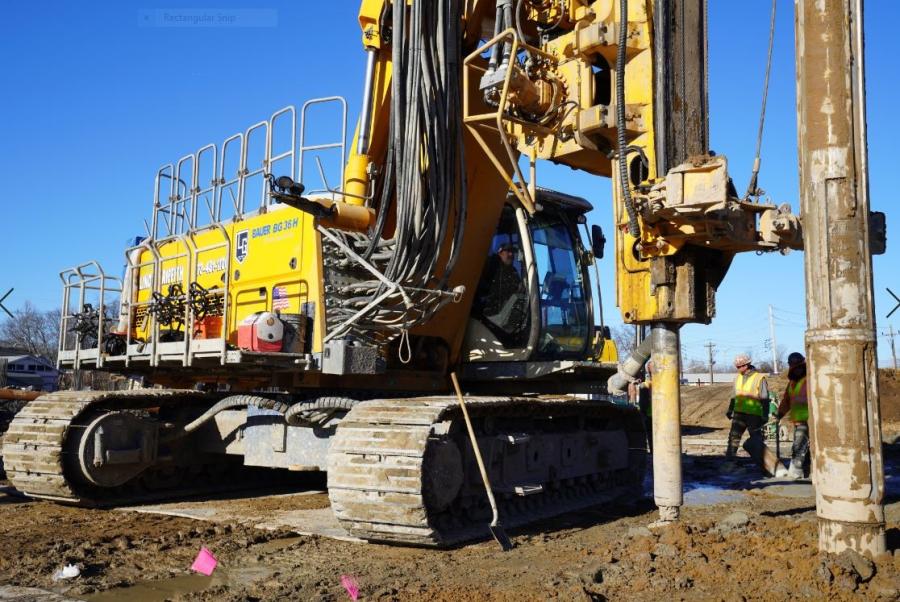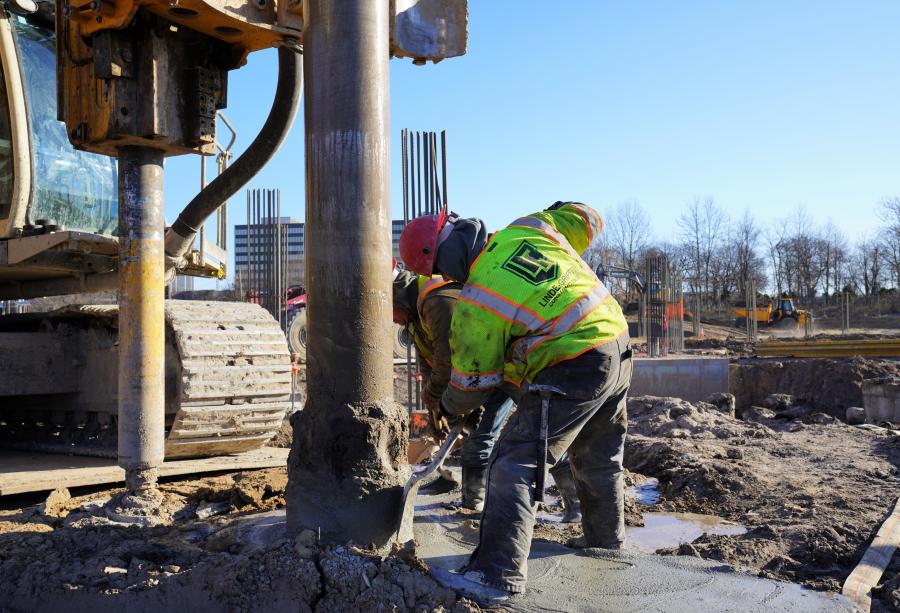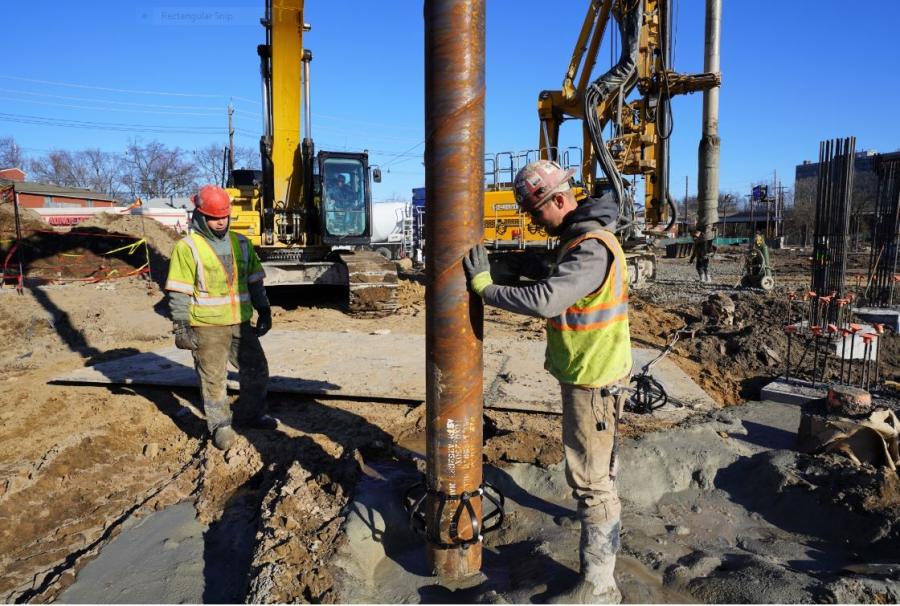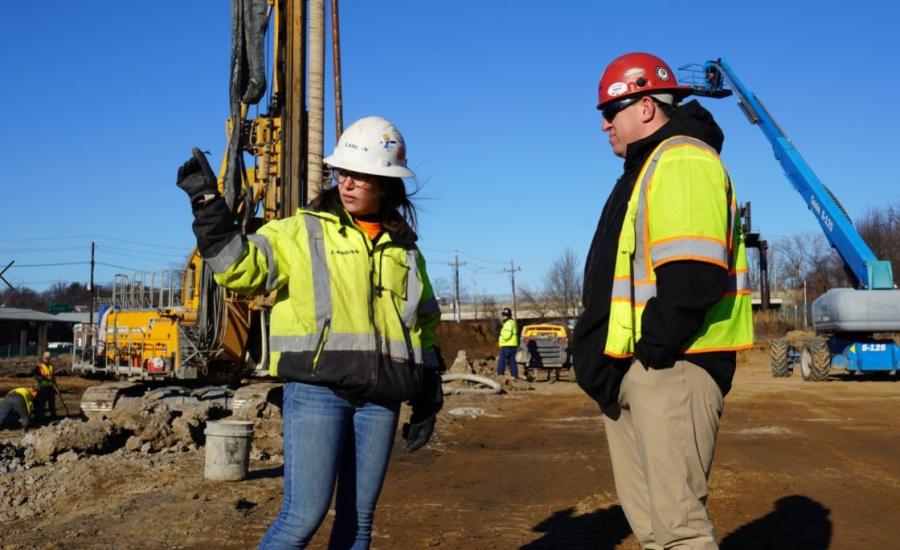Linde-Griffith Construction Company saved the owner of a multi-story condo project in Hacksensack, N.J., millions of dollars by recommending a switch to full displacement piles (FDP).
Linde-Griffith Construction Company may be 111 years old, but the contractor is far from set in its ways. This is why the owner and engineer of a multi-story condo project in Hackensack, N.J., called on them when its original contractor was unable to reach bearing capacity on a test pile program.
The end result was a cost-saving switch to full displacement piles (FDP) using a Bauer BG 36 H drilling rig and custom tooling.

The center of the FDP operation was a Bauer BG 36 H drilling rig and custom tooling supplied by Equipment Corporation of America.
Linde-Griffith – founded in 1909 – was primarily a pile driving contractor until about 20 years ago when it expanded into foundation drilling.
"We've seen more and more engineers seeking techniques that offer greater capacity with less noise and vibration," said Linde-Griffith's Senior Executive Vice President Mike Shannon.
"We still drive tens of thousands of piles a year, but we now specialize in all foundation types as well as ground improvement methods – not just driven piles."
The Switch from Driven Piles to FDP
In the midst of densely clustered apartment buildings and businesses, the yellow mast of a Bauer BG 36 H drilling rig towered more than 90 feet over the landscape in the urban enclave of Hackensacky. The Linde-Griffith field crew braved fierce 30-plus-mile-per-hour winds and single-digit windchills as the lynchpin machine of its FDP operation bored through the frosty soil.
The roughly 6-acre pizza slice-shaped Hackensack site is framed by an active New Jersey Transit line and two roadways. An unseasonably warm and wet winter turned the ground into virtual swampland, but puddles were glazed over and the mud was like stone on this frigid January morning.
The Hackensack project started out as a driven pile project. The previous contractor had run a pile driving analyzer (PDA) test and was unable to reach the design capacity despite installing various pile types to depths of up to 175 ft. The owner and engineer reached out to Linde-Griffith's John Shannon looking for ideas.
Linde-Griffith suggested using FDP piles. Mike Shannon summarizes the FDP technique: "The piles don't rest on rock here, you get your load bearing because the displacement and compaction of the soil, and grout column build up enough friction to meet capacity.
"The results were impressive when we static load tested the piles," recalled Mike Shannon. "We were able to achieve the loads they needed with a 55-foot FDP pile."
The decision to award Linde-Griffith the contract for production piles was clear.
The switch to FDP piles was also the most environmentally sound choice, according to Mike Shannon.
"They did all the remediation but still didn't want any material to be exported," he said. "FDP allowed us to keep all soils in the ground where they belong."
The BG 36 H As the Centerpiece
The FDP operation revolved around the BG 36 H drilling rig. Linde-Griffith owns a fleet of drilling rigs, including two Bauers acquired from Equipment Corporation of America's (ECA) New York/New Jersey branch.
Linde-Griffith and ECA are 100-plus-year-old, family-owned companies with an inter-generational connection. ECA's New York, New Jersey Regional Sales Manager Bruce Langan sold equipment to Mike's grandfather Peter H. Shannon – the first member of the family to take control of Linde-Griffith in 1971.
But the connection goes beyond Langan, according to Mike Shannon.
"They're never afraid to take a phone call and they're always there to help you, even though they know a sale might not come out of it," he said. "The mechanics, the sales team, the engineering staff, is what makes ECA, ECA"
It was January of 2018 when the BG 36 H executed test piles at Hackensack. The original plan was to have two rigs driving the FDP operation. The other was to be a BG 28 H. By the time permitting and environmental delays had been cleared, Linde-Griffith's BG 28 H was tied up on other projects. It was agreed that the BG 36 H would be the only drilling rig on site.

Linde-Griffith worked with ECA to equip the BG 36 H with 20 in. (51 cm) FDP tooling to drill 1,322 FDP piles from 52 to 57 ft.
The FDP Process
Linde-Griffith worked with ECA to equip the BG 36 H with 20-in. (51 cm) FDP tooling to drill 1,322 FDP piles from 52 to 57 ft. Each pile consisted of a 20-in. grout column with a 10-by-¼-in. hollow pipe in the center to provide additional shaft friction. The FDP piles created enough shear and base resistance so landing the pile on competent rock was unnecessary.
Linde-Griffith executed each FDP pile in a sequence. First, the displacement tool bored down to the desired depth to loosen and densify the surrounding soil, leaving an open excavation. 4 ½ to 5 ½ cu. yd. of 5,000-psi grout was then pumped into each hole under pressure through a hollow drill stem as the BG 36 H extracted the displacement tool. The rotation of the tool densified any loose material. The reinforcement cage was then dropped, and in some cases vibrated, into the fresh concrete to finish off the pile.
"On an auger cast pile you're relieving the pressure of the ground as you're drilling down and the spoils are coming out," Mike Shannon explained. "Here, you're actually creating more pressure because the soil is staying in the ground and pushing against the sides."
The FDP piles were laid out in a grid pattern with single piles around the perimeter for grade beams and caps containing up to six piles for areas supporting the heaviest column loads.
Drilling was not especially challenging in these soil conditions, but the grid pattern and FDP process itself caused increasing resistance with each pile.
"In these clusters," Shannon explained, "the first couple are always a lot easier because you don't have any resistance. But the more piles and concrete you put in, the more you're displacing and densifying the soil around the existing piles and it gets tighter and tighter."
Another challenge was that Linde-Griffith had to maintain a 10-ft. distance from piles with uncured concrete.
"It's based on how your layout is with the spacing of your piles, and how you plan," said Shannon. "With this type of pile [FDP], you need to really project two to three days ahead to maintain production."

Four and a half to 5 ½ cu. yds. of 5,000-psi grout was pumped into each bored hole under pressure through a hollow drill stem as the BG 36 H extracted the displacement tool.
The Importance of Bauer FDP Tooling
Bauer tooling was critical to the FDP operation, according to Shannon.
"It's all Bauer displacement tooling designed specifically for this project," he said. "It was engineered to achieve the required loads with these soil conditions."
ECA's Philadelphia's Director of Bauer Product Sales & Service Gordian Ulrich worked closely with Linde-Griffith to design the tooling. The training also covered the B-Tronic System, setting up drilling and grouting parameters, and tying in concrete pumps.
"Gordian is one of a kind," said Shannon. "One of the best things about him is that he loves to share his knowledge and experience."
Friction was an issue. The soil conditions and grout acted like sandpaper on the tooling, especially the displacement bulb above the auger flight and the cutting teeth on the wear plates.
"Quality control is very important out here so we change the tooling out once a week," said Shannon, noting that extras are on hand at all times. "Then we just refurbish, re-weld, hardface and bring them out when we need them.
"The main concern on this job was that a driven pile couldn't achieve the load required," said Shannon. "Our decision to bring in the larger 20-inch full displacement tooling combined with the quality control this machine offers made this project. The amount of information you get from that machine is unique and very impressive."

The Bauer tooling was engineered specifically to achieve the required loads with the soil conditions on the Hackensack FDP project.
B-Tronic System Provides Abundant Data and Automation
The quality control Shannon speaks of is driven by the Bauer B-Tronic system. Both Linde-Griffith and the project's third-party engineer have access to such data as stroke count, grout pressure and drilling depth via a desktop computer or mobile device. There is no second guessing whether a pile is driven to the proper depth and contains the right amount of concrete. There also was a safety benefit since the engineer was able to monitor drilling from a safe distance because B-Tronic transferred the operator's view to an iPad.
The B-Tronic system doesn't simply provide data. It also has a feature called B-Drive, which automates monotonous operations. Linde-Griffith's operator, for example, was able to program the BG 36 H to drill to a specific depth by simply typing in parameters. During concrete placement, he plugged in the targeted grout volume and pressure. B-Drive automatically extracted the tooling once those numbers were achieved.
Not only did this ensure a consistently grouted column, but it also allowed Linde-Griffith to share the exact amounts of concrete consumed with the owner.
The B-Tronic system is especially handy for the always on the move Linde-Griffith executive team since they have the unique policy of having an owner on-site at every project.
"We have it set up where I can view it from anywhere," said Shannon, noting that he travels between sites all day. "I keep a laptop in my car so if I'm not here, I can see what's going on."
The B-Tronic system essentially allows Shannon to log in to see what his BG 36 operator can see whether driving down the New Jersey Turnpike or in his office.
Strong Production Despite Messy Site Conditions

Linde-Griffith was installing up to 25 FDP piles in less than 10 hours each day despite short winter days and unusually wet site conditions.
Linde-Griffith was installing up to 25 FDP piles in less than 10 hours each day, which could have been even higher. Productivity was hampered by shorter days, muddy site conditions, and up to 45 minutes spent cleaning the BG 36 H and tooling at the end of each day.
"You're dealing with concrete and water in freezing conditions so you need to spend some time thoroughly washing everything out," said Shannon. "You don't want concrete to harden inside the machinery or you'll have major problems the next day."
Hackensack is prone to flooding and this particular site didn't drain well. Mobility wasn't an issue since the BG 36 H is a tracked machine, but Linde-Griffith did use steel plates in softer areas. This move was more about safety to keep the top-heavy rig stable, especially when working near slopes.
Linde-Griffith started drilling the first week of October of 2019 and finished by February of 2020. Strong production and smart planning resulted in the project being completed on schedule.
Shannon knows that opportunities to shave time off a project schedule are always obvious in hindsight, but he also knows that Linde-Griffith's recommendation to switch to FDP piles saved the owner millions of dollars.
"Truthfully," Shannon said, "we just try to save our customers money."

Mike Shannon (R) discusses the FDP operation with Kristen Shetler, staff engineer of Langan Engineering, the engineer of record.
Today's top stories
























